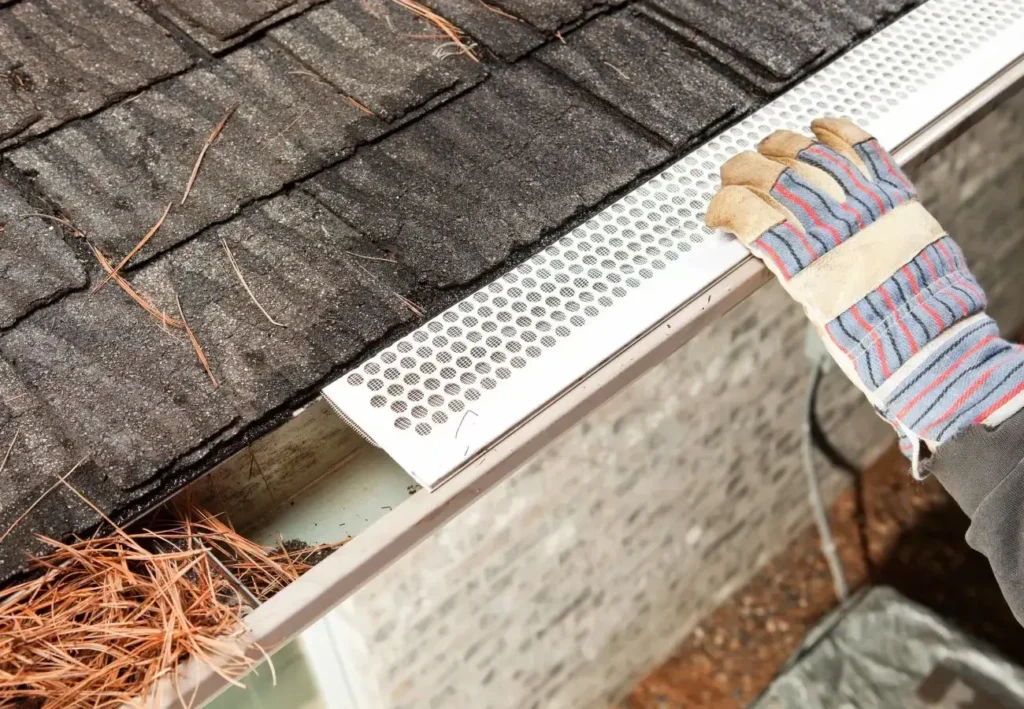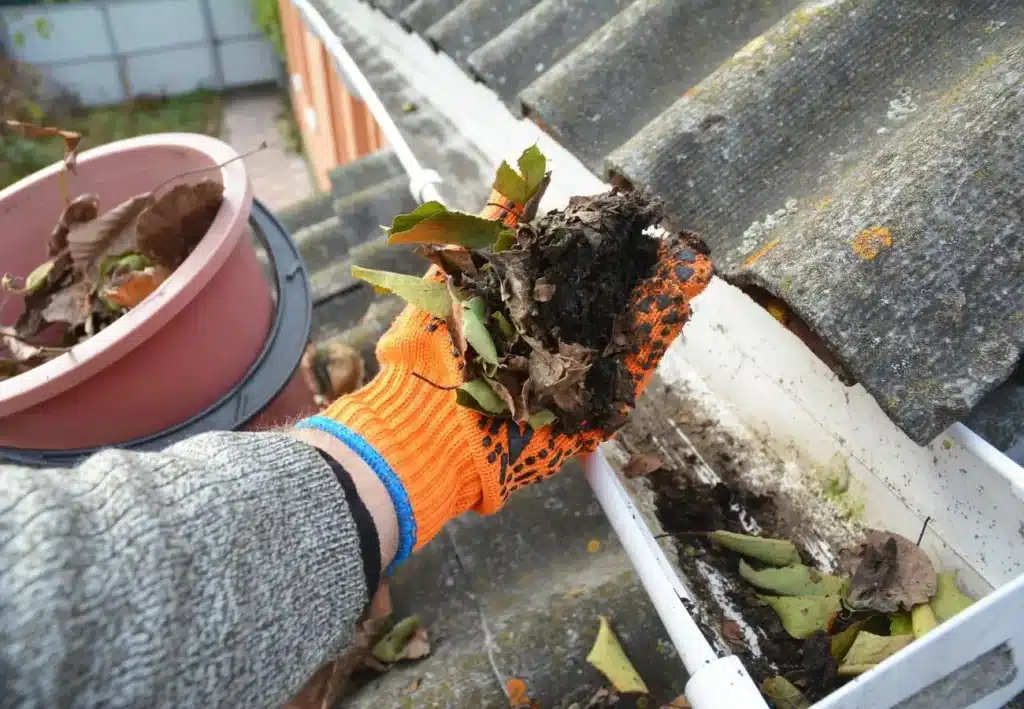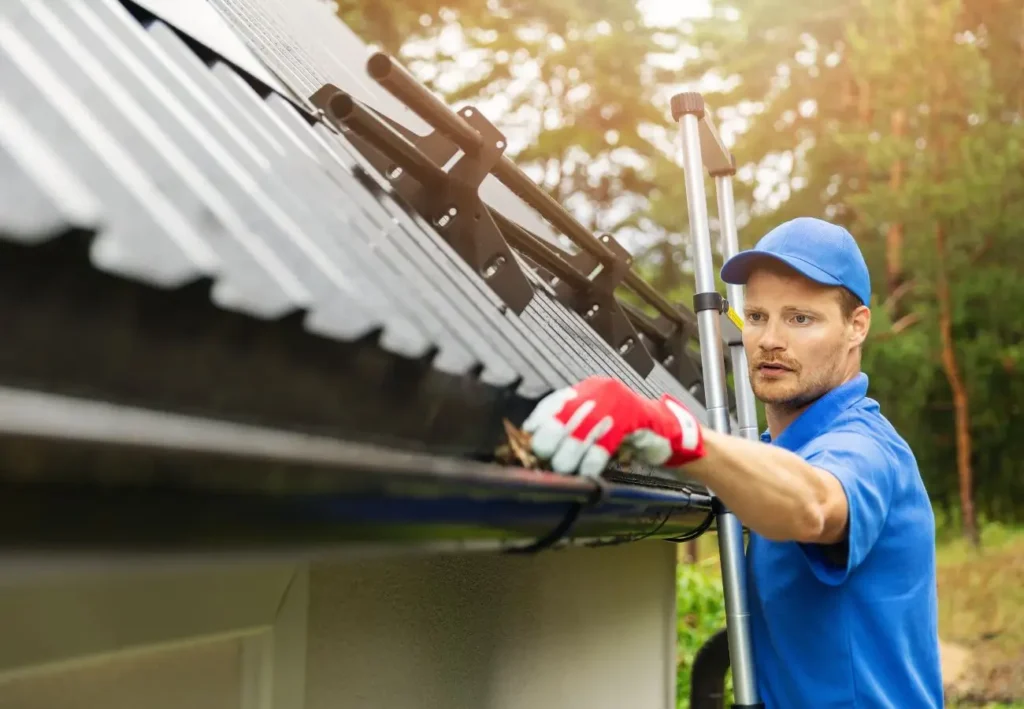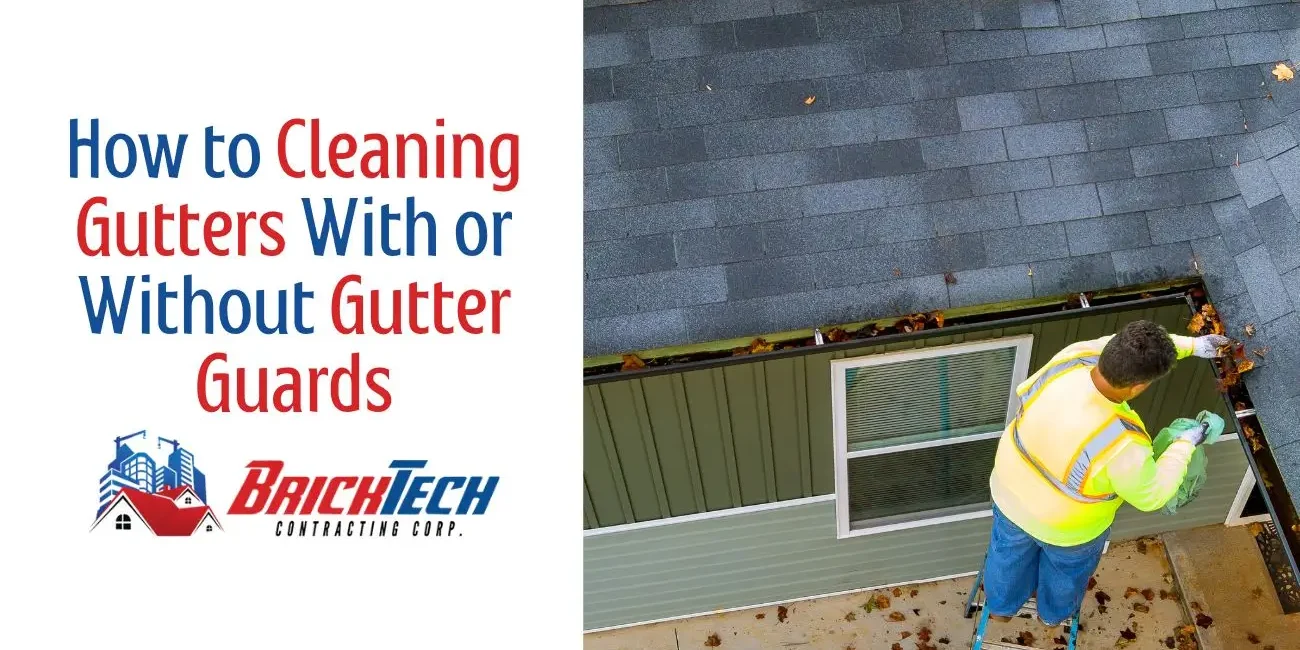Gutters play a vital role in protecting your home from water damage. Clogged gutters can lead to a cascade of issues, including foundation problems, leaky basements, and unwanted pests. While gutter guards offer a valuable line of defense by preventing leaves, twigs, and debris from accumulating, regular maintenance is still essential. This streamlined guide equips you with the knowledge and steps to efficiently clean gutters with or without gutter guards, ensuring the continued protection of your home.
Why Regular Gutter Maintenance Matters
As a homeowner, you might think of gutter maintenance as just another tedious task. However, the significance of clean gutters hit home for me last fall when I noticed water pooling around the foundation after a heavy rain. A quick inspection revealed clogged gutters and a bit of preventative maintenance could have saved me a lot of hassle. Here’s why you shouldn’t underestimate the importance of gutter maintenance:
- Water Damage Prevention: Overflowing gutters can cause water to seep into your foundation, walls, and roof, leading to expensive repairs and potential structural problems.
- Foundation Issues: Pooling water around your foundation can weaken it over time, causing cracks and settlement.
- Leaky Basements: Clogged gutters can redirect water flow toward your basement walls, increasing the risk of leaks and moisture damage.
- Pest Infestation: Stagnant water in clogged gutters becomes a breeding ground for mosquitoes, rodents, and birds.
- Curb Appeal Decline: Overflowing gutters can stain your home’s exterior, detracting from its overall appearance.

Understanding Gutter Guards and Benefits of Using Gutter Guards
Gutter guards come in various designs, each with specific benefits. They are designed to keep large debris out of your gutters, reducing the frequency of cleanings. However, understanding the different types can help you choose the best option for your home. Here’s a quick breakdown of popular types and their advantages:
Mesh and Screen Gutter Guards
Mesh and screen gutter guards are among the most popular choices. They feature small holes that allow water to pass through while blocking larger debris such as leaves and twigs. These guards are effective and relatively easy to install, making them a favorite among homeowners.
Reverse Curve or Surface Tension Gutter Guards
Reverse curve gutter guards are designed to direct water into the gutter while forcing debris to slide off the edge. They are highly effective at preventing clogs but can be more challenging to install. These guards are ideal for areas with heavy foliage.
Brush and Foam Gutter Guards
Brush and Foam gutter guards fit directly into the gutter, blocking debris while allowing water to flow through freely. These options are affordable and easy to install but may require more frequent cleaning to prevent buildup within the guard material.
No matter what type you have, gutter guards offer several benefits:
- Reduced Cleaning Frequency: Gutter guards significantly minimize the amount of debris entering your gutters, reducing the need for frequent cleaning.
- Clog Prevention: By keeping leaves and other debris out, gutter guards prevent clogs that could lead to water overflow and damage.
- Pest Deterrence: By eliminating the accumulation of debris and stagnant water, gutter guards make your gutters less attractive to unwanted pests.
Safety First: Essential Precautions for Gutter Cleaning
Safety is paramount! Here are some crucial precautions to take before tackling any gutter-cleaning project:
- Sturdy Ladder: Use a secure and stable ladder that can reach all areas of your gutters. Avoid overreaching and always relocate the ladder when necessary.
- Work Gloves and Goggles: Gloves protect your hands from debris and sharp edges, while goggles shield your eyes from dust and flying particles.
- Spotter: Consider having a trusted helper hold the ladder for added stability during cleaning.
Taking these precautions minimizes the risk of falls and injuries while working at heights.
Tools You’ll Need for Efficient Gutter Cleaning
Gathering the right tools beforehand can streamline your cleaning process:
- Sturdy Ladder (as mentioned in safety precautions)
- Work Gloves
- Safety Goggles
- Gutter Scoop or Trowel: This tool helps remove debris from the gutter channel efficiently.
- Garden Hose with Spray Nozzle: A hose with a spray nozzle allows you to flush out any remaining debris and ensure proper water flow.
- Bucket or Trash Bag: This will hold the debris you remove from your gutters.
Using the correct tools ensures thorough debris removal without damaging the gutter guards or the gutter system.
Step-by-Step Guide to Cleaning Gutters with Gutter Guards
Inspection and Initial Cleaning:
- Begin by inspecting your gutter guards for any visible clogs or debris buildup on their surface.
- Remove any large leaves, twigs, or other debris by hand or using your gutter scoop.
Removing and Cleaning Gutter Guards (if applicable):
- If your gutter guards are removable, carefully take them off for a more thorough cleaning.
- Rinse them thoroughly with water from your hose to remove any stuck-on dirt and debris.
Cleaning the Gutters:
- Once the guards are removed (if applicable) or you’ve cleared debris from the top, use your gutter scoop or trowel to remove any remaining debris from the gutter channel.
- With the hose and spray nozzle attachment, flush the gutters thoroughly to ensure water flows freely through the gutters and downspouts. Look for any blockages by observing the water flow.
- If you notice blockages in the downspout, use a plumber’s snake or a strong stream of water to dislodge the clog. Avoid using high-pressure washers, as they can damage your gutters and gutter guards.

Reinstalling Gutter Guards (if applicable):
- Once the gutters are clean and free of debris, securely reinstall your gutter guards, ensuring they are properly fastened and aligned according to the manufacturer’s instructions.
Cleaning Up:
- Dispose of the debris you collected in your bucket or trash bag responsibly. Consider composting leaves and twigs if possible.
Dealing with Specific Challenges
Stubborn Clogs: For particularly stubborn clogs, you may need to use a plumber’s snake or a specialized gutter cleaning tool designed to dislodge hard-to-remove debris.
Difficult-to-Remove Gutter Guards: Some gutter guards can be tricky to remove. Ensure you follow the manufacturer’s instructions carefully, and consider seeking help if the guards are particularly resistant. In some cases, professional assistance may be the best option to avoid damaging the guards or gutters.
Cleaning Gutters Without Gutter Guards
While gutter guards offer numerous benefits, some homeowners may not have them installed or prefer to avoid them. Here’s a simplified guide to cleaning gutters without gutter guards:
Tools You’ll Need:
- Sturdy Ladder (as mentioned in safety precautions)
- Work Gloves
- Safety Goggles
- Bucket or Trash Bag
- Leaf Scoop or Rake (optional)
- Garden Hose with Spray Nozzle
Step-by-Step Guide:
- Safety First: As always, prioritize safety. Ensure you have a secure ladder and a spotter if possible. Wear work gloves and goggles for protection.
- Clear Loose Debris: Start by removing any loose leaves, twigs, and debris from the gutters by hand or using a leaf scoop or rake.
- Flush with Water: Use a garden hose with a spray nozzle to thoroughly flush out the gutters. Direct the spray towards the direction of the downspout to remove any remaining debris and ensure proper water flow.
- Downspout Check: Observe the flow of water through the downspout. If you notice blockages, you may need to use a plumber’s snake or a strong stream of water to dislodge the clog. Avoid using high-pressure washers, as they can damage your gutters.
- Cleaning Up: Dispose of the debris you collected in your bucket or trash bag responsibly. Consider composting leaves and twigs if possible.
Additional Tips:
- Schedule Regular Cleanings: Without gutter guards, gutters are more susceptible to clogging. Aim to clean them at least twice a year, or more frequently in areas with heavy foliage.
- Fall Cleaning is Crucial: Make sure to perform a thorough cleaning before winter to prevent ice dams from forming due to clogged gutters.
- Consider Professional Help: If you have difficulty cleaning your gutters due to height limitations, physical constraints, or the presence of stubborn clogs, consider hiring a professional gutter cleaning service.
Maintenance Tips for Gutter Guards
To maintain gutter guards and ensure their optimal performance, it is important to clean them regularly, at least twice a year or more frequently if the home is surrounded by trees or experiences heavy rainfall. Signs that indicate gutter guards need maintenance include water overflow during rain, visible debris on the gutter guards, or the presence of pests and insects in the gutters.
Regular maintenance of gutter guards involves removing any accumulated debris, checking for any damage or corrosion, and ensuring that the gutter guards are securely in place. By maintaining gutter guards, homeowners can prolong the lifespan of their gutter system and prevent potential water damage to their homes.
Learn more: Do Gutter Guards Work in Heavy Rain?
Professional Help for Cleaning Gutters with Gutter Guards
Consider hiring professionals for gutter cleaning if:
- Gutters are difficult to access
- The home has multiple stories
- You are unable to perform the cleaning due to physical limitations or time constraints

Professional gutter cleaning services offer expertise in handling various types of gutter guards, use specialized equipment for thorough cleaning, and can identify and address any underlying issues with the gutter system.
Customer Testimonials
One homeowner shared, “After trying to clean my gutters myself and struggling with the steep angle of my roof, I decided to hire Brick Tech Contracting Corp. They were thorough, professional, and quick. My gutters have never worked better, and I have peace of mind knowing my home is protected.”
Another satisfied customer said, “Brick Tech’s team was fantastic. They not only cleaned my gutters but also provided a detailed inspection and made necessary repairs. It saved me a lot of potential future headaches.”
Conclusion
In conclusion, gutter guards are an effective solution for minimizing the need for frequent gutter cleaning and protecting the home from water damage and pests. However, regular maintenance and cleaning of gutters with gutter guards are essential to ensure their optimal performance. By using the right tools, techniques, and maintenance tips, homeowners can efficiently clean their gutters with gutter guards and prolong the lifespan of their gutter system.
If you’re in NYC and need professional help with gutter installation, repair, and even gutter cleaning, consider reaching out to Brick Tech Contracting Corp. Our expert services can ensure your gutters are in top shape, providing peace of mind for homeowners like you.
Frequently Asked Questions About Gutter Guards and Maintenance
Do Gutter Guards Eliminate the Need for Cleaning?
While gutter guards significantly reduce the amount of debris entering your gutters, they do not eliminate the need for cleaning. Some small particles can still get through, necessitating occasional maintenance.
How Often Should I Clean My Gutters with Gutter Guards?
It’s recommended to inspect and clean your gutters at least twice a year. However, if you live in an area with heavy foliage, you may need to clean them more frequently to prevent clogs.
Can I Install Gutter Guards Myself?
Many gutter guards are designed for easy DIY installation. However, if you’re unsure or uncomfortable with the process, hiring a professional can ensure they are installed correctly and function as intended.
What Are the Benefits of Professional Gutter Cleaning?
Professional gutter cleaners have the experience and equipment to thoroughly clean and inspect your gutters. They can identify potential issues and perform necessary repairs, ensuring your gutters remain in optimal condition.








